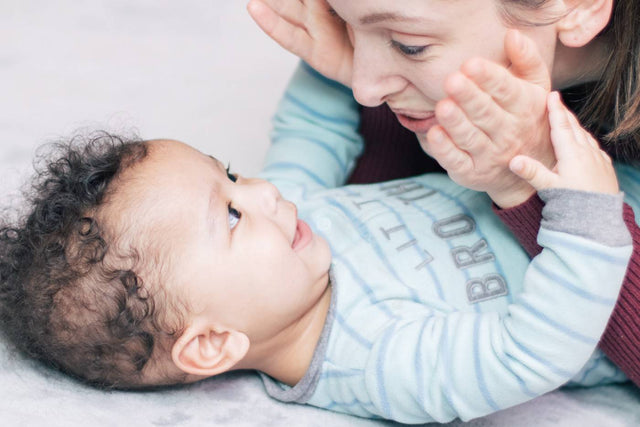What is Object Permanence?

If a furry, four-legged creature runs behind the sofa, does it exist? What about a ball that rolls out of sight: Is that still here? And when Mommy leaves in the morning, will she be gone forever?
While grownups know that pets, toys, and parents remain even when out of sight, young babies aren’t too sure. In fact, it’s not until your little one is about 8 months old that they learn that things they thought disappeared forever, really don’t. This realization is called object permanence.
What is object permanence?
In short, object permanence is your baby’s ability to learn that people and objects that seemingly vanish still exist…even if they can no longer see them. Before object permanence settles in, if you put one of your little one’s toys behind your back during playtime, they might become upset when they can’t see the toy anymore. (My choo-choo is gone forever!) Or, on the flip side, they might become totally disinterested and move on because, well, the toy is no longer here.
Somewhere around 8 months old, however, when, say, SNOObear disappears behind you, your baby’s reaction might change. The lightbulb has turned on! Your precious tot realized that, yes, SNOObear went away, BUT it’s somewhere. Then around 10 months, your baby will likely start to actively search for their beloved missing bear, craning their head to find out where their favorite lovey is hiding.
Why is object permanence important?
Object permanence is a critical part of your baby’s cognitive development. It’s the very start of what’s called symbolic thought, which is the ability to conjure up an image of something that’s not physically in front you. Without understanding object permanence, your sweet tyke wouldn’t be able to move on to more advanced milestones, such as imaginative play, learning how to talk, and creating memories.
When do babies develop object permanence?
Before your baby can get their burgeoning brains around object permanence, they need to first learn that things exist. This is what’s called object identity. Object identity means that your tot can see an object—for instance, a rattle—have it taken away, and then be able to recognize the rattle when it comes back. Object identity for familiar caretakers kicks in around 2 months of age. Soon after, your baby can identify their favorite objects.
While there’s no set-in-stone age when your baby will grasp object permanence, it typically happens when they are around 8 months old, though some believe it can start between 4 and 7 months. But it’s really better to think of object permanence as a work in progress, especially since research suggests that object permanence is something that your 10- to 12-month-old baby is likely still working on.
How do babies learn object permanence?
Once your baby understands object identity, you can help them develop their object permanence through fun activities. Try playing a rousing game of peek-a-boo by covering your face with your hands or putting a light scarf over your baby’s face and quickly pulling your hands or scarf away. You can also hide toys under a blanket and ask your baby to try to find them…or play with an old-school jack-in-the-box. Another way you can help your baby learn object permanence is by talking to them when you leave the room. This way, they still hear you and know you’re there without seeing you.
As your baby starts to realize that objects (and people!) exist after they disappear, they may get upset when you leave them. Sure, your baby may know that you still exist when you walk out the door, but now they’re troubled because they understand that you’re not available to them. After all, your nugget doesn’t yet understand the concept of time—who knows when you’ll return! (Cue possible separation anxiety.)
This is an exciting time for your baby! They’re going through a lot of changes…and trying to understand the world around them. But it’s important to remember that all babies develop a little bit differently. While object permanence is expected to develop around 8 months, many start to grasp the concept earlier or later than this. Talk to your baby’s healthcare provider if you have concerns about their development.